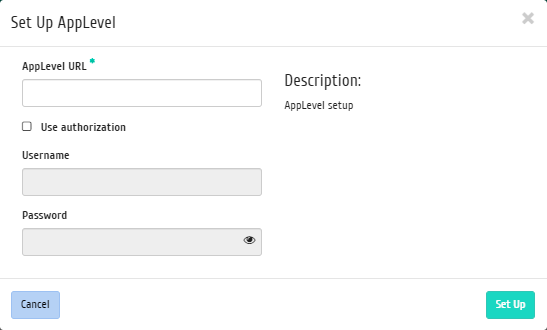«Projects» tab¶
Tab displays list of projects:
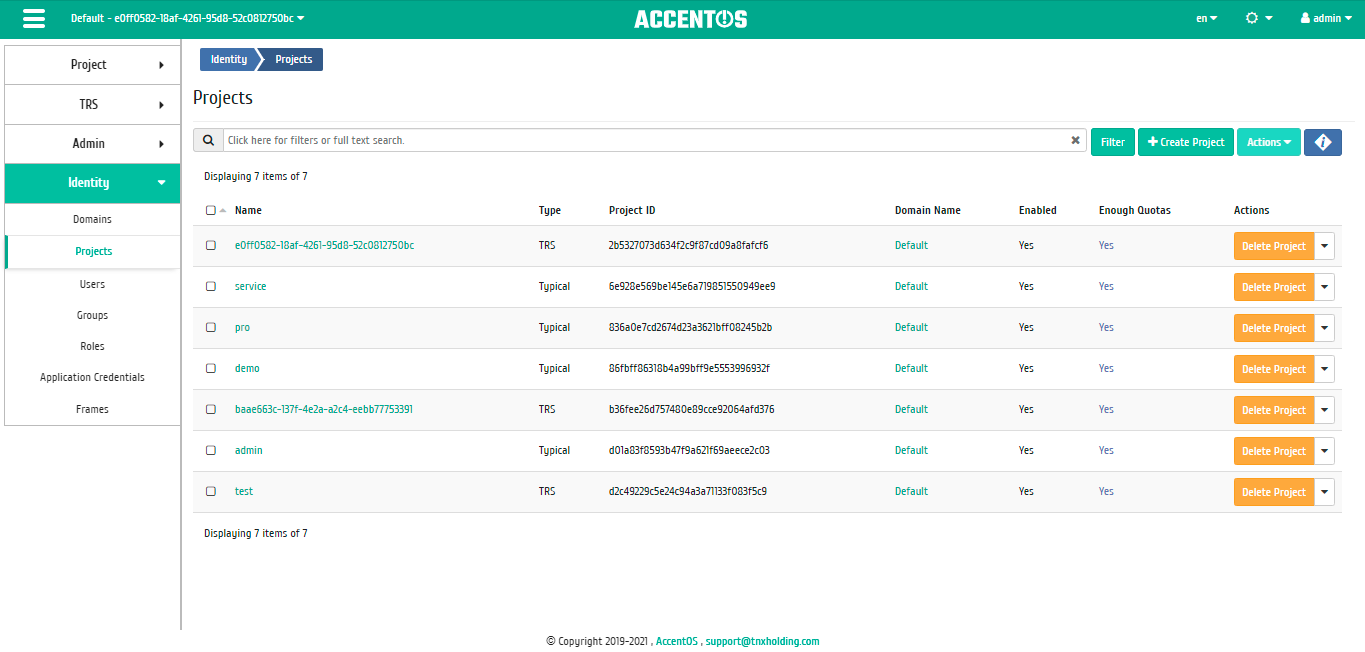
List of projects¶
| Field name | Description |
|---|---|
| Name | Project name, assigned by the user upon creation. |
| Type | Project type, is set automatically at creation. Possible types are:
|
| Description | Description of the project, filling is available at creation and can be changed in the general list of all projects. |
| Project ID | Project ID, it is set automatically upon creation. |
| Domain Name | Domain Name. It is link to go to detailed information about the domain. |
| Enabled | Project status. It changes in the general list of all projects. |
| Enough Quotas | Parameter indicating the availability of sufficient resources for the project. Possible values are:
|
Sorting and filtering tools are available for the list of projects. Sorting is available for all fields. It is possible to sort the objects marked with a check mark. Filtering tool works by the name of any of the fields, for example, an incomplete input of the name.
Also, user can view detailed information about project. Detailed information about the object opens in separate block on the right side of the page when you click on project name link. This does not close the list of objects and is displayed on the left side of the page. To close block of detailed information use the  button, to open a block of detailed information use the button
button, to open a block of detailed information use the button  .
.
Detailed information about the project is presented in several internal tabs.
«Overview» tab¶
Tab displays detailed information about selected project:

Detailed parameters of project¶
In particular, tab displays total amount of project resources (quotas), as well as the amount of resources used.
Page also provides data on service level of the project:
- Up time (%);
- Recovery time (hours);
- Movable is parameter indicating whether the transfer of project resources from one computational node to another is allowed or prohibited during the balancing process. By default, transfer is allowed.
«Usage» tab¶
Page shows instances that are currently using project resources:

Project usage statistics¶
Data is displayed at the time of entering the module and to view information for the previous period of time, use the selection of the required date. In addition, you can get text document with areport on resource consumption in CSV format.
Sort tool is available for all displayed fields. Fields are sorted in ascending and descending order. It is also possible to sort the objects marked with a check mark.
«Action log» tab¶
Tab displays information about the history of operations on the project and project instances:

Project action log¶
| Field name | Description |
|---|---|
| Request ID | Request identifier. |
| Parent request | Identifier of the request, which is the parent of this one, for example, if an action was performed on a request from RSclient or Scheduler. If the action is performed on request from the Dashboard, then there is no parent request. |
| Action | Action name. |
| Start time | Date and time of the task start in the format: dd.mm.yyyy, hh.mm.ss. |
| User | Name of the user who initiated the action. |
| Subject type | Type of object on which the action was performed. |
| Subject name | Name of object on which the action was performed. |
| Result | Result of the action. Possible values are:
|
| Result details | Detailed description of the result. Also, if the action was performed during the execution of scheduled task, the task identifier is indicated. |
Sorting and filtering tools are available for journal. Fields are sorted in ascending and descending order. Filtering tool works on all fields.
Note
Action log tab is only visible for projects in the current domain.
«Scheduled tasks» tab¶
Tab displays list of scheduled tasks on the project:
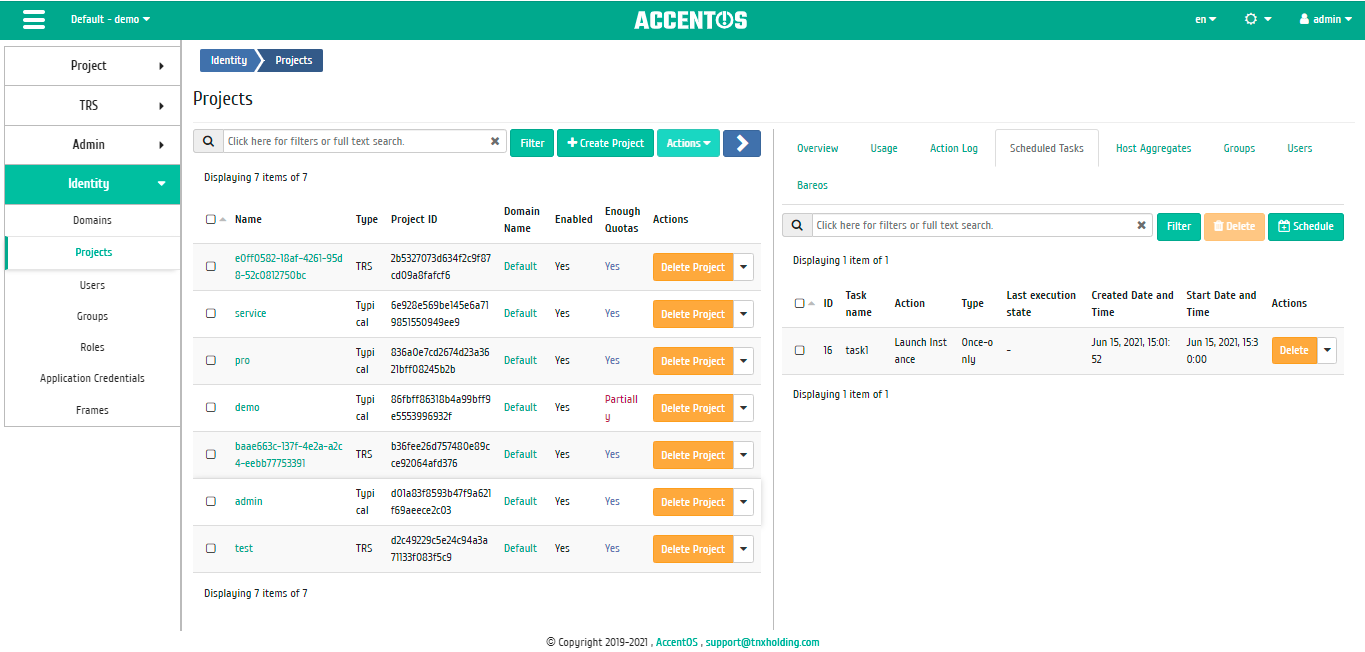
Scheduled tasks list¶
Sorting and filtering tools are available for list of scheduled tasks. Fields are sorted in ascending and descending order. Filtration is performed according to following parameters:
- ID is task ID. Incomplete input is allowed;
- Task name. Incomplete input is allowed;
- Action is action name. Incomplete input is allowed;
- Type is the type of task execution. Only exact input is allowed;
- Last execution state is task status. Incomplete input is allowed.
To view detailed information about specific task, click on the “More” button. All actions are described in more detail in “Scheduled Tasks” tab.
On tab there is button “Schedule”, when you click on it, you go to the form for scheduling task on the object.
«Host Aggregates» tab¶
Information about the aggregators of nodes assigned to the project is displayed:
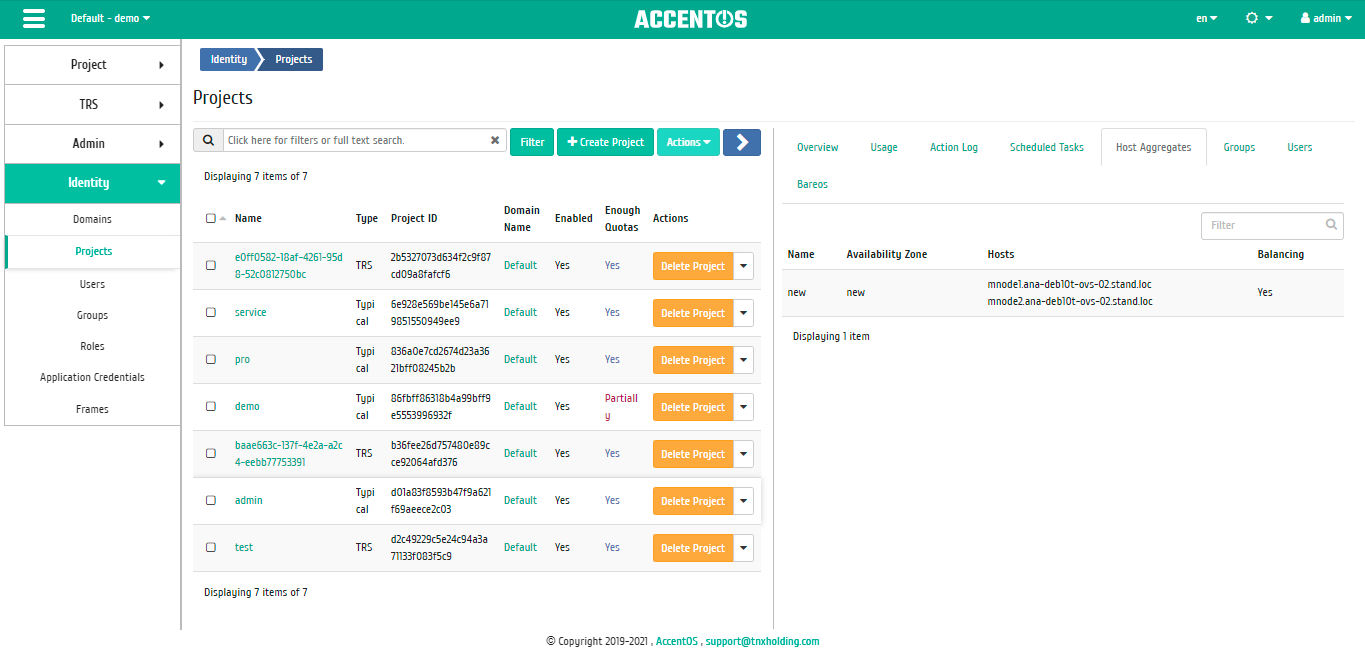
Project host aggregates¶
«Groups» tab¶
Important
Tab is not displayed if the selected project belongs to different domain.
Tab displays list of user groups for which access to this project is granted within the current domain:

List of project groups¶
«Users» tab¶
Important
Tab is not displayed if the selected project belongs to different domain.
Tab displays list of user groups for which access to this project is granted within the current domain:
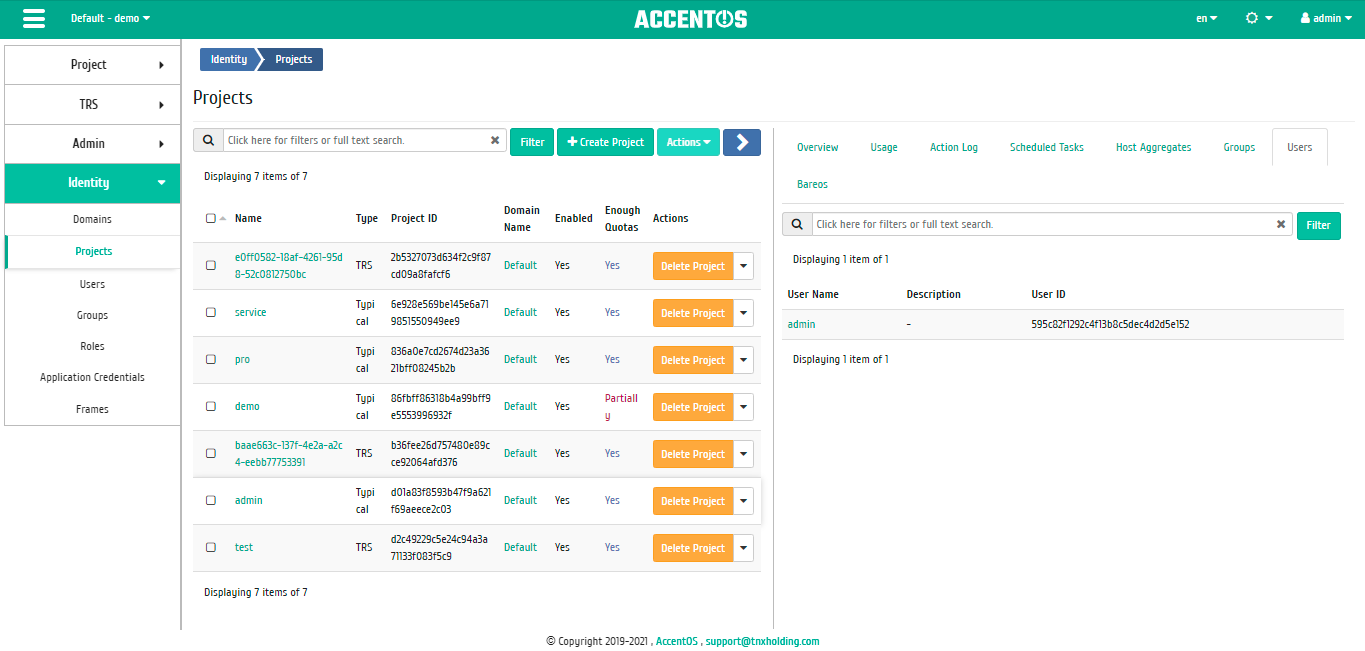
List of project users¶
«Bareos» tab¶
Tab displays the Bareos backup system settings for the project domain:

Bareos backup system settings¶
«Resources» tab¶
Important
Tab is not displayed if integration with public clouds is not configured for the project.
Tab displays resources of the public cloud with which the project is integrated:
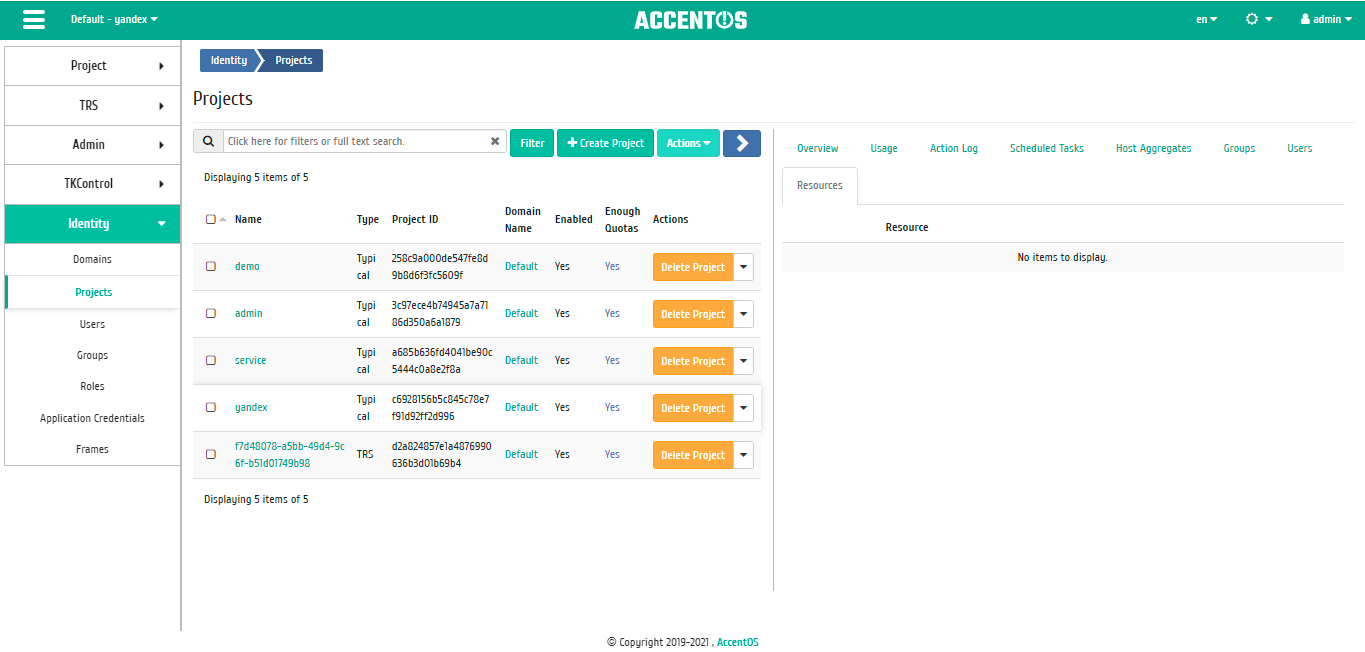
Public cloud resource list¶
| N | Action | Description |
|---|---|---|
| 1 | Create project | Adding container with necessary resources and participants. All previously created users can be project members. |
| 2 | Disable project | Changing the project state from active to inactive. Action not available for current project and service project. |
| 3 | Schedule | Execution of the selected action at specified point in time. It is also possible to repeat the action after a certain period of time. Scheduling is only possible if there are available actions. |
| 4 | Modify groups | Editing list of project groups. |
| 5 | Set as active project | Switching from the active project to the selected one. |
| 6 | Set AppLevel | Configuring project access to the golden images management service AppLevel. |
| 7 | Set Monitoring | Integration of the project with the monitoring system Zabbix. |
| 8 | Modify quotas | Setting the maximum possible amount of resources for use by users within the project. |
| 9 | Edit project | Name, status and project description changing. |
| 10 | Delete project | Deleting selected project. When deleted, all tasks scheduled for it are deleted along with the project. Deleting project that contains instances is prohibited. |
| 11 | Enable project | Changing the project state from inactive to active. |
| 12 | Manage host aggregates | Managing host aggregates of the selected project. |
| 13 | Manage members | Editing list of project members. |
Listed actions are available for execution with respect to one selected project - by selecting required action in the “Actions” field of corresponding line in the list of projects.
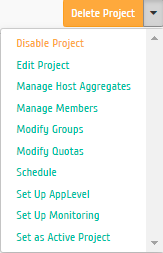
Individual project actions¶
Actions can also be triggered on multiple pre-selected projects. To do this, you need to mark required projects and select group action:
Features of work¶
Adding project¶
In the general list on the control panel using the «Create project» button, open the wizard window for creating project. Fill in project parameters:
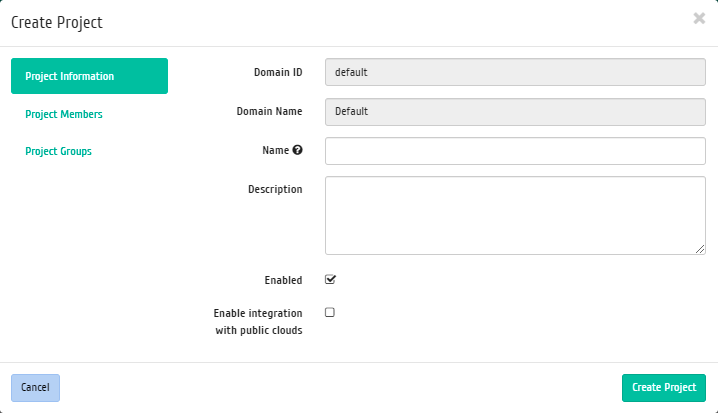
Project creation window¶
Project information:
- Name is optional field, if the value is empty, the name is generated automatically;
- Description is optional field;
- Flag «Active» is the state of the project after creation;
- Integration with public clouds enabled is enabling or disabling integration of the project with the public cloud. Integration with public clouds can be configured only when creating project, it cannot be edited later.

Project creation window¶
Project members:
- All users is a list of all available users;
- Project members is a list of project members.
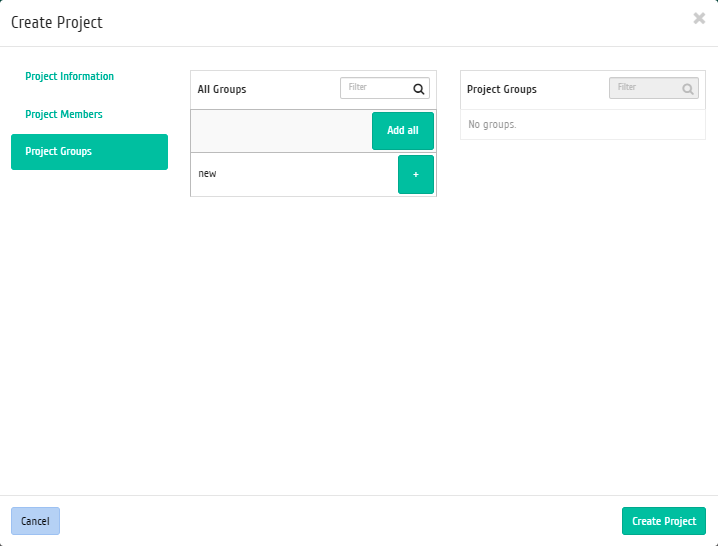
Project creation window¶
Project groups:
- All groups is a list of all available groups;
- Project groups is a list of creating project groups.
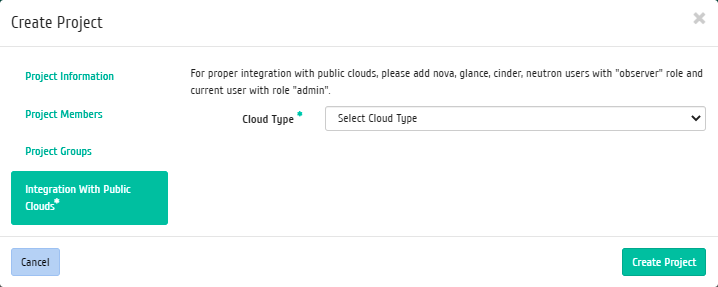
Project creation window¶
Note
Tab is available only when the integration with public clouds is enabled.
On the tab, you need select the type of public cloud with which you want to integrate the project: AWS or Yandex. And also it is needed to specify parameters for integrating the project with public clouds:
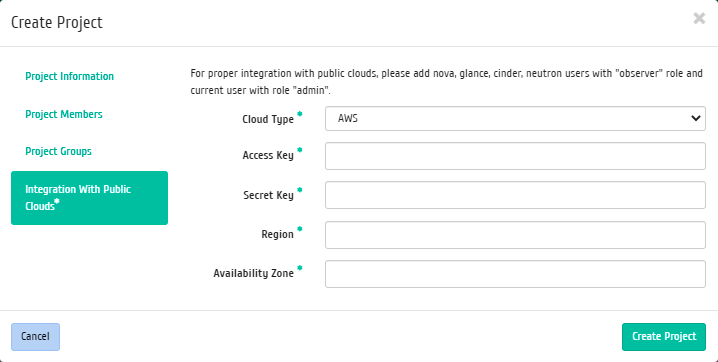
Project creation window¶
For AWS:
- Access key is public cloud access key;
- Secret key is secret key;
- Region is the region of the public cloud;
- Availability Zone is public cloud availability zone.
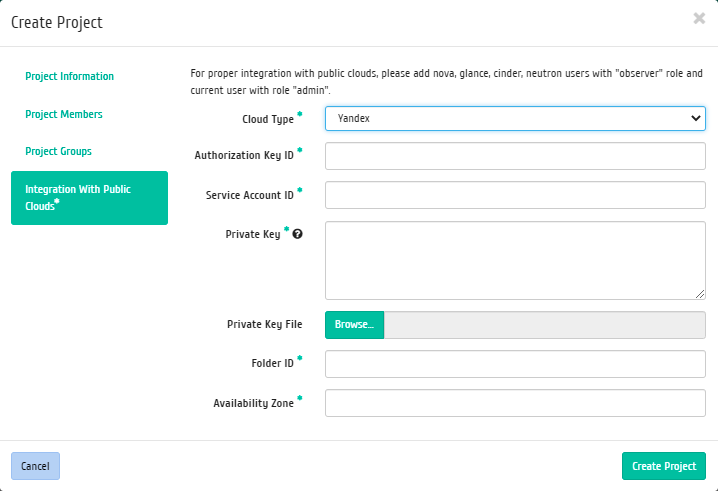
Project creation window¶
For Yandex:
- Authorized key ID is the authorized key identifier in Yandex.Cloud;
- Service account ID is identifier of the service account in Yandex.Cloud;
- Private key is private key (enter manually or upload private key file);
- Folder ID is the catalog ID in Yandex.Cloud;
- Availability zone is public cloud availability zone.
Follow directions on pages of the wizard to select the options you want. We complete creating procedure with the “Create project” button. After that, correctly created project will be displayed in the general list. Otherwise, the system will return you to the wizard window indicating reasons for the impossibility of its creation.
Scheduling actions¶
Select required project and call action:
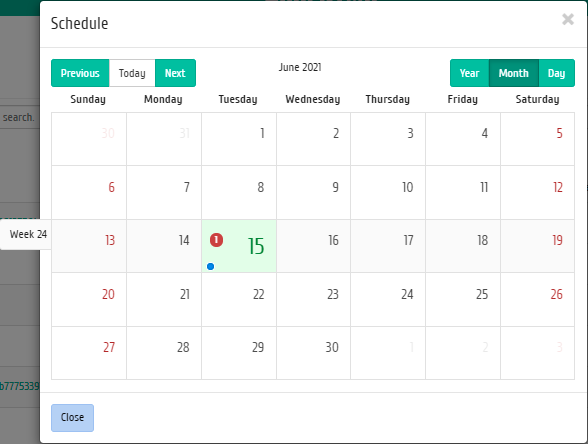
Scheduled action calendar¶
In the wizard window that opens, select the date. Highlighted days indicate the presence of planned actions on this object for the date, and blue marks indicate their number.
To go to the next step in the field of the selected date, click on an empty area or number. In the first case, you will be redirected to the task creation window. When you click on the number, you will be immediately prompted to select the duration:
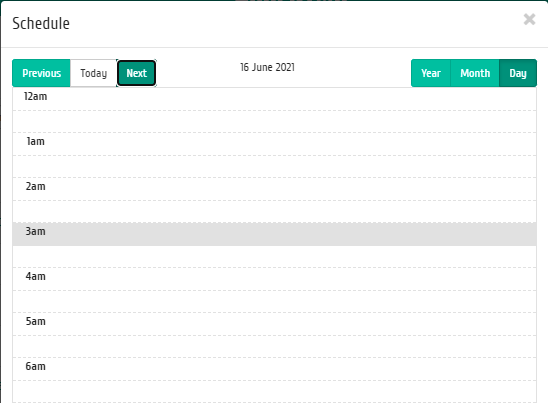
Scheduled action calendar¶
Specify the rest of the parameters of the scheduled action, which contain the internal tabs of the master window:

Task creation window¶
Let’s analyze their content in more detail:
Select an action:
Task name is the name of the scheduled action; if empty, it will be generated automatically;
Action is list of available actions on the project:
- Launch base instance (only for typical projects);
- Launch instance (only for typical projects);
- Launch TRS instance (only for TRS projects);
- Run openstack shell command;
- Run curl request;
- Allocate TRS instances.
More information about available actions can be found in the corresponding section of documentation.
User credentials:
- Username is the login of the user planning the action;
- Password is password of the user planning the action;
- Project is working project of user planning the action.
Details:
- Type is the type of task. Following types are distinguished:
- Single task;
- Repeating task.
- Repeat, selection of values of the task execution interval. Following options are available:
- Days;
- Hours;
- Minutes;
- Working days (from Monday to Friday);
- Days of the week;
- Year.
- Repeat with interval, selection of task execution interval;
- Start date is the start date of the task in the format dd.mm.yyyy;
- Start time is the start time of the task in the format hh.mm;
- Time zone is the time zone according to which the task execution time is indicated;
- End is the conditions for terminating the task. Following conditions are distinguished:
- Never, when choosing a flag, the task becomes unlimited;
- Max number of repetitions is limiting the number of task executions;
- Date is the deadline for the task execution, set in the format dd.mm.yyyy.
Instance launch details:
- Instance name;
- Availability zone;
- Instance count;
- Source;
- Flavor;
- Networks.
Base instance launch details:
- Instance name;
- Instance count;
- Image name;
- Network;
- CPU;
- RAM;
- HDD.
TRS instance launch details:
- Instance name;
- Instance count.
Complete the procedure with confirmation button.
Note
To return to the page with the calendar and change the date, use the «Cancel» button.
Created task is displayed in the “Scheduled Tasks” tab.
AppLevel setup¶
Configuring project access to the AppLevel module, which makes it possible to manage gold images for OpenStack projects. Select the required project and call the “Configure AppLevel” action:
In the window that opens, specify:
- AppLevel address is the address of AppLevel golden image management module.
- Checkbox “Use authorization”, when selecting the checkbox, authorization data, such as username and password, are used for connection.
- Username is AppLevel username. The field becomes active when the “Use authorization” checkbox is selected.
- Password is AppLevel password. The field becomes active when the “Use authorization” checkbox is selected.
Complete the procedure with «Set» button.
Note
To download images from AppLevel, go to the project for which this feature was configured. Then, on the “Project” - “Compute resources” - “Images” tab, call the “Load AppLevel images” action.
Monitoring setup¶
Note
To integrate the project with the monitoring system Zabbix, you need to configure Zabbix and Monitor module.
Function allows you to integrate the project with monitoring system Zabbix. Action is available in the general list of all projects. Select the required project within which the monitoring system will be integrated. After calling the action, you need to set the login and password of the new user in Zabbix:
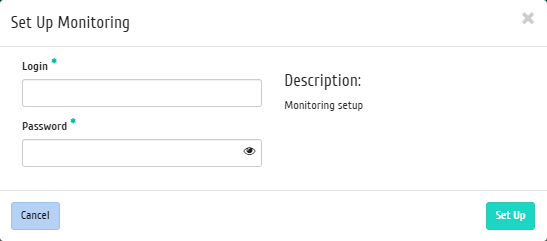
Monitoring settings window¶
Confirm the entered credentials and click on the “Configure” button. Username must be unique within the Zabbix monitoring system. Wait for the message that the user has been successfully added. In case of error, you will be shown a message indicating the reason for the unsuccessful addition. Credentials of the Zabbix user created to integrate the project will be needed to log in to the monitoring system Zabbix and view monitoring data.
After adding new user for instances of the project, monitoring templates become available Zabbix. You can customize templates on the «Integration» - «Monitoring» tab using the «Manage templates» function.
Important
Monitoring system integration Zabbix performs only within the selected project.
Project members management¶
Function is available in the list of actions of the required project. It allows to change project members list.
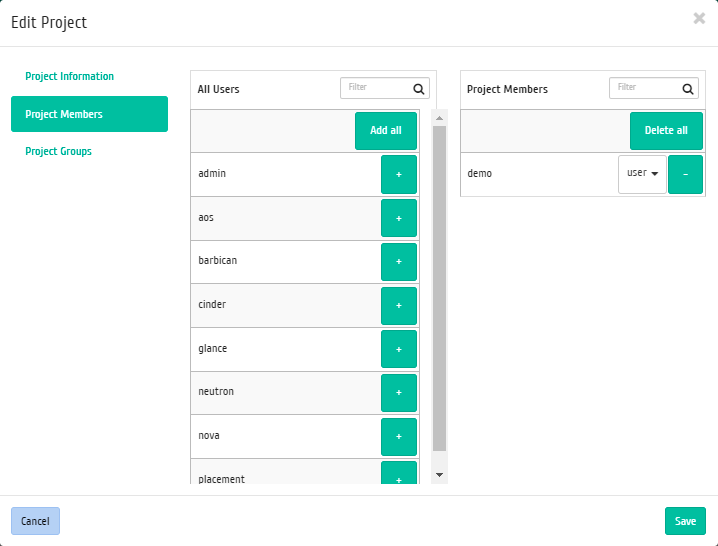
Project member management window¶
In the window that opens, select required parameters. Complete the procedure with «Save» button.
Aggregates management¶
Function is available only in the general list of all projects. Select the required project and call the action «Manage Host Aggregates»:
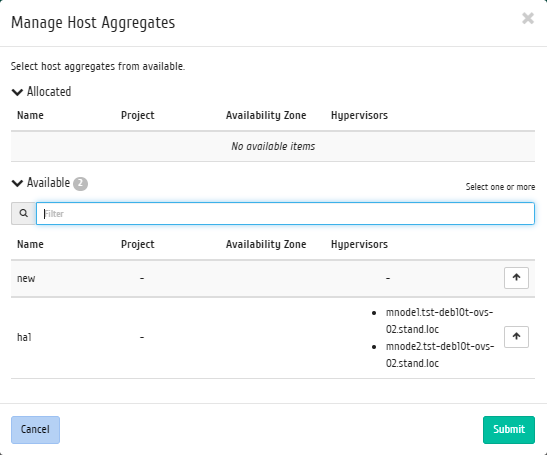
Host Aggregates management window¶
Install required aggregators from the list of available ones and complete the procedure with «Submit» button.
Modifying project quotas¶
Function is available in the list of actions of the required project. It allows to change project quotas.
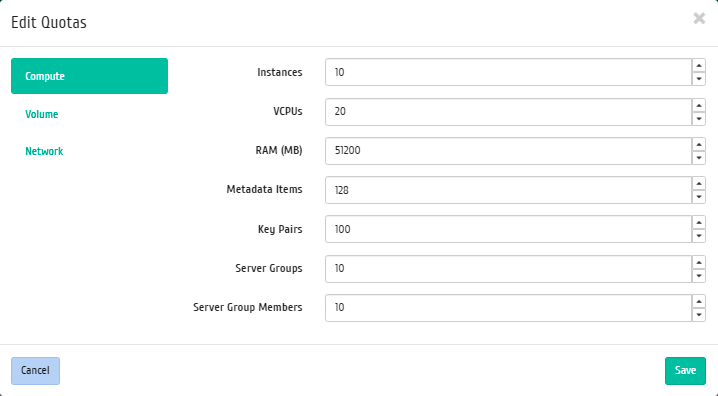
Project quotas change window¶
Project quotas editing form has three tabs:
- Compute;
- Volume;
- Network.
In the window that opens, change required parameters. Complete the procedure with «Save» button.
Editing project¶
Function is available only in the general list of all projects. After calling action in the window that opens, change required parameters:
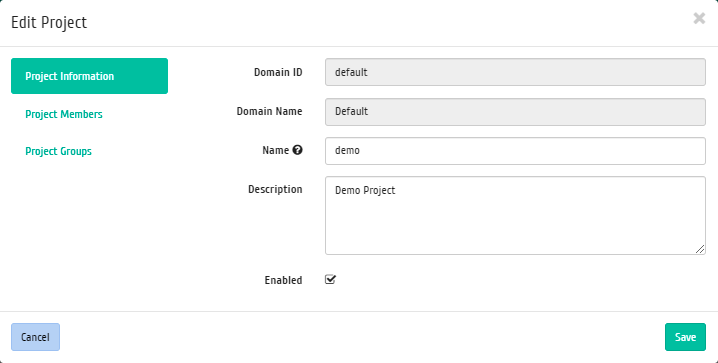
Window for changing project parameters¶
- Name, any name is available;
- Description is optional field;
- Flag «Enabled» is selection of the project state. Disabling the current project is not possible;
- Project members, project members management;
- Project groups, project groups management.
Complete the procedure with confirmation button.
Group editing project¶
Function is available on the top panel in the general list of all projects. Select required ones and call the action «Edit projects». In the window that opens, set parameters for the selected projects:

Window for changing parameters of projects groups¶
- Description is optional field;
- Flag «Enabled» is selection of the project state. Disabling the current project is not possible;
- Project members, adding of project members ;
- Project groups, adding project groups.
Complete the procedure with confirmation button.
Changing project groups¶
Function is available only in the general list of all projects. After calling action in the window that opens, change required parameters:
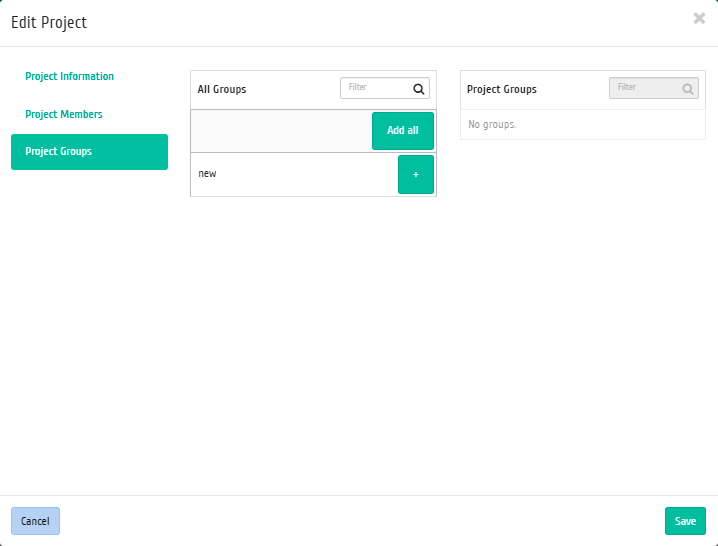
Project group management window¶
Complete the procedure with confirmation button.
All available actions not listed above are performed in their master windows with prompts or have ease of management that does not need description.
